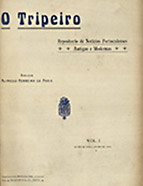

................................
As a result, entries in sections such as Arquivo nobiliárquico portuense [Porto Nobiliary Archive], Museu Municipal do Porto [Municipal Museum of Porto], Iconografia histórica portuense [Historical Iconography of Porto], and Da música portuense [On Porto’s Music] were more consistent, with contributions from figures like Luís de Pina, Julieta Ferrão, Delfim Santos, and Armando Leça. However, the "archive of the most glorious traditions of Portugal's most industrious city" only lasted for a year due to its low financial profitability and moderate reception among the public, competing with other more scientifically focused titles.
A long hiatus followed until O Tripeiro was revived in 1945, during a flourishing cultural and educational period in Porto that had begun about a decade earlier. This resurgence coincided with a municipal policy centred on the Gabinete de História da Cidade [City History Office], with Magalhães Basto heading the council's Cultural Services. It was then that the industrialist António Sardinha, after purchasing the assets of O Tripeiro , invited him to take over the management of the periodical. This marked what could be considered the publication’s golden period, characterised by its longevity, relevance, and visibility. Under the motto "Do Porto - Pelo Porto” [“From Porto–For Porto”], it adapted to the publishing market, adopting a colloquial and engaging tone as it transformed into O Tripeiro: revista mensal de divulgação e cultura, ao serviço da cidade e do seu progresso [ O Tripeiro : a monthly magazine for dissemination and culture, at the service of the city and its progress.] In total, the 5th series (1945-1960) spanned fifteen years, with a monthly publication of 12 issues each. The series featured a new graphic design for both the cover and the body of the text, adopting a more avant-garde style, heavily illustrated with various types of images, and including annual indexes organised by different indicators. The first editorial firmly reaffirmed the founder's original guidelines and general programme. As a repository of news from Porto, it remained a unique publication in Portugal, almost like a spiritual heritage, reshaped to meet the new literary and iconographic demands of its readership. The parallels with 1908 are also evident in the core principles of historical study, the recognition of scientific collaborators, the historical-geographical scope of Porto and its region, and the connection between past, present, and future. As stated, "History, the memory of peoples, has a practical value; it must be regarded, moreover, as a source of energy, as an imperative for the future."
This work is financed by national funds through FCT - Foundation for Science and Technology, I.P, in the scope of the projects UIDB/04311/2020 and UIDP/04311/2020.
